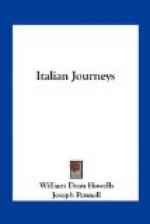So Ferdinand died childless, and, it is said, in sore remorse, and was succeeded in 1626 by his brother Vincenzo, another hope of the faith and light of the Church. His brief reign lasted but one year, and was ignoble as it was brief, and fitly ended the direct line of the Gonzagas. Vincenzo, though an ecclesiastic, never studied anything, and was disgracefully ignorant. Lacking the hereditary love of letters, he had not the warlike boldness of his race; and resembled his ancestors only in the love he bore to horses, hunting, and women. He was enamored of the widow of one of his kinsmen, a woman no longer young, but of still agreeable person, strong will, and quick wit, and of a fascinating presence, which Vincenzo could not resist. The excellent prince was wooing her, with a view to seduction, when he received the nomination of cardinal from Pope Paul V. He pressed his suit, but the lady would consent to nothing but marriage, and Vincenzo bundled up the cardinal’s purple and sent it back, with a very careless and ill-mannered letter to the ireful Pope, who swore never to make another Gonzaga cardinal. He then married the widow, but soon wearied of her, and spent the rest of his days in vain attempts to secure a divorce, in order to be restored to his ecclesiastical benefices. And one Christmas morning he died childless; and three years later the famous sack of Mantua took place. The events leading to this crime are part of one of the most complicated episodes of Italian history.
Ferdinand, as guardian of his brother’s daughter Maria, claimed the Duchy of Monferrato as part of his dominion; but his claim was disputed by Maria’s grandfather, the Duke of Savoy, who contended that it reverted to him, on the death of his daughter, as a fief which had been added to Mantua merely by the intermarriage of the Gonzagas with his family. He was supported in this claim by the Spaniards, then at Milan. The Venetians and the German Emperor supported Ferdinand, and the French advanced the claim




